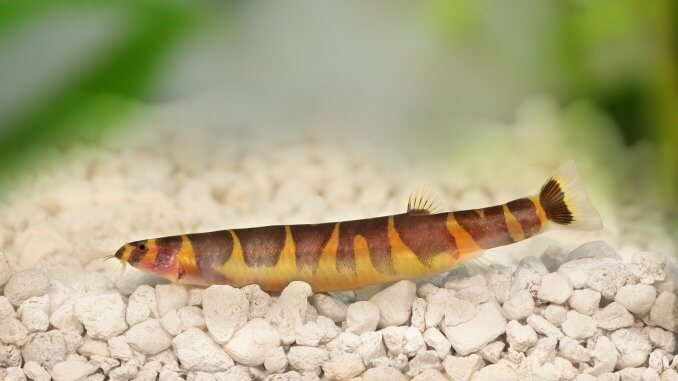
The kuhli loach is a freshwater fish of the Cobitidae family. The kuhli loach is closely related to other loach species, which are often mislabeled as color variations of the kuhli loach. These species include the Java loach, the black kuhli, the panda kuhli, and the silver kuhli.
Kuhli loaches have yellow eel-like bodies encircled by thick brown or black bands.
The fish are a popular choice for home aquariums because of their peaceful, sociable temperaments and unique burrowing behavior.
TABLE OF CONTENTS
Kuhli Loach Facts & Overview
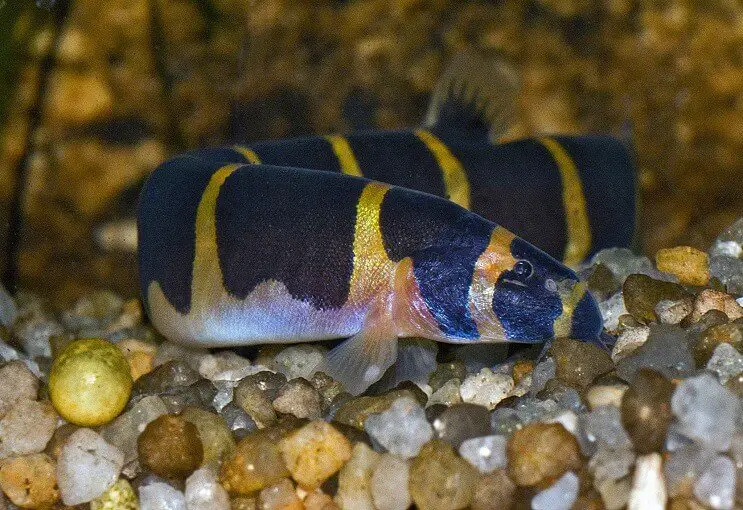
| Scientific name: | Pangio kuhlii |
| Common names | Kuhli loach, coolie loach, leopard loach |
| Distribution: | Southeast Asia — Sumatra, Malaysia, Thailand, Singapore, and Borneo |
| Size: | 3–4 inches |
| Life expectancy: | 7–10 years |
| Color: | Yellow with thick brown or black stripes |
| Diet: | Omnivore |
| Temperament: | Peaceful |
| Minimum tank size: | 20 gallons |
| Temperature: | 73–86°F (23–30°C) |
| pH: | 5.5–6.5 pH |
| Hardness: | 0–5 dGH |
| Care level: | Easy |
| Breeding: | Egg-scatterer |
Origin
The kuhli loach originates from Southeast Asia and frequents clean, slow-moving streams and rivers in Sumatra, Malaysia, Thailand, Singapore, and Borneo.
Although kuhli loaches aren’t a schooling species, the fish are social and often form groups in the wild.
In their natural habitat kuhli loaches are nocturnal and scavenge the riverbed for food at night. Kuhli loaches are common in the wild, and many of the fish are wild-caught instead of raised in an aquarium before selling.
Kuhli Loach Size & Lifespan
Adult kuhli loaches reach up to five inches long in the wild, and 3–4 inches long in the aquarium. Males and females are the same lengths, and males have larger pectoral fins and a thicker dorsal cross-section than females. Females have rounder bellies than males, especially during breeding.
The lifespan of a kuhli loach is 7–10 years. In the right tank environment, a kuhli loach can live even longer than this – up to 14 years.
Availability
Though common among aquarists, kuhli loaches are less common than other popular aquarium species. Online sellers are guaranteed to sell at least one type of kuhli loach:
- Imperial Tropicals sells kuhli loaches and black kuhli loaches.
- Aquatic Arts sells striped kuhli loaches.
Kuhli loaches cost $3–$5 per fish. Kuhli loaches thrive in groups of at least three, bringing up the total initial cost to $9–$15.
Appearance & Behavior
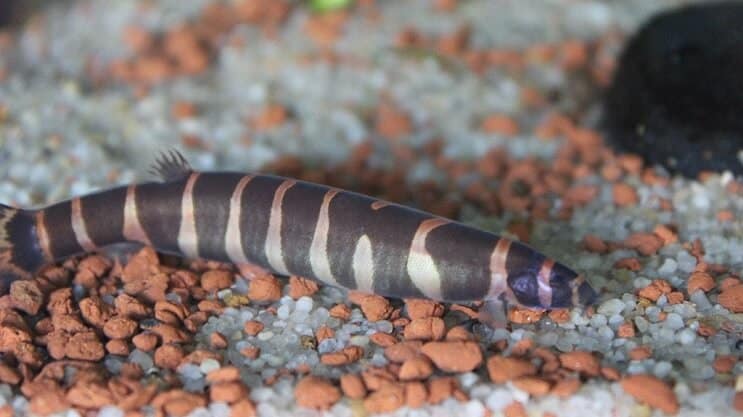
Kuhli loaches are eel-shaped fish, and the most common kuhli loach coloring is yellow with brown or black bands.
The kuhli loach is known for its peaceful disposition. Kuhlis are shy, cautious, and overall peaceful fish that are well suited to community tanks.
Colors, Patterns, Fins, and Sex Differences
The common striped kuhli loach has a pinkish-yellow body with 10 to 15 thick, dark bands that encircle the fish from head to tail. The underside of the kuhli loach is lighter than the top and sides of the fish’s body.
The kuhli loach has small fins and four pairs of barbels around the mouth. The eyes of the kuhli loach are covered by transparent skin, and the fish’s dorsal fin starts further past the middle of the body compared to most other fish.
Faint body scales and a lack of head scales give the kuhli loach an eel-like appearance.
There are several differences in appearance between male and female kuhli loaches. The male kuhli loach’s tail curves inwards, while the female’s tail is straight. Male loaches have more black markings than females, and stressed or diseased kuhli loaches become pale in color.
Black kuhli loaches are a similar subspecies to the striped kuhli loach. Black kuhli loaches have the same fins and body shape as striped kuhli loaches, but black kuhli loaches are bandless with solid black or dark brown bodies and small purple dots on either side of the snout.
Typical Behavior
Kuhli loaches are peaceful, non-aggressive fish that swim at the bottom of the tank. Although kuhli loaches are a shy species, the fish enjoy one another’s company and are more active in the tank when housed with other kuhli loaches compared to being housed alone.
Kuhli loaches love to burrow. It’s not uncommon for kuhli loaches to burrow so far into the substrate that fishkeepers assume the fish long-lost, only for the loaches to reappear months later.
As nocturnal fish, kuhli loaches sleep during the day and are active at night.
Kuhli Loach Care & Tank Requirements
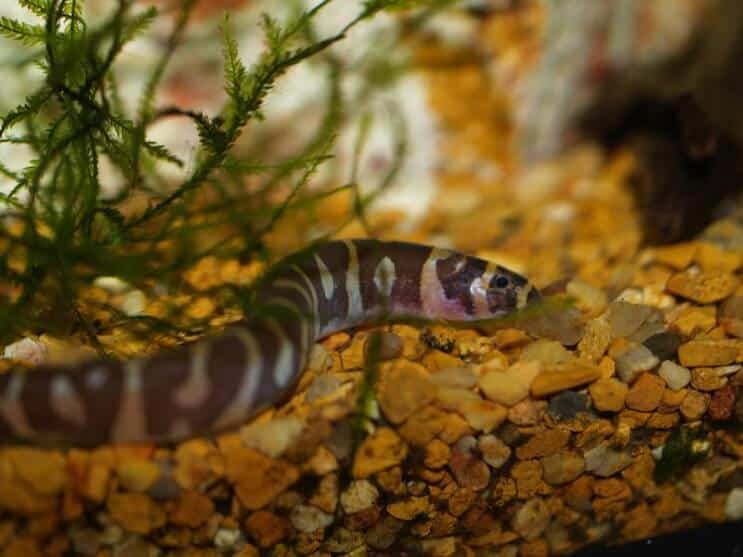
Caring for kuhli loaches is more challenging than caring for other common freshwater fish because kuhli loaches lack scales, making the fish susceptible to skin diseases. Maintaining exact water parameters that resemble the fish’s natural habitat is essential to prevent diseases in a kuhli loach tank.
You should feed kuhli loaches fish flakes and live or frozen food.
Habitat and Tank Requirements
The natural habitat of the kuhli loach is tropical, slow-moving, freshwater rivers and streams, which are shaded by tree canopies and dense vegetation. You should replicate this habitat as closely as possible to allow your kuhli loaches to thrive in the tank.
A substrate is essential for kuhli loaches because of the fish’s burrowing habits. Use a fine gravel-sand mix that won’t scratch the loach’s body.
Kuhli loaches prefer a heavily planted tank. Sturdy, deep-rooted plants to add to your tank include cryptocoryne and Java fern. You can also add peat moss to the tank to mimic the leaf litters that kuhli loaches are used to in the wild.
Rocks, driftwood, and twisted roots offer a place for kuhli loaches to explore and hide.
The tank’s lid should be sturdy because kuhli loaches can jump out of the tank.
Tank Conditions
The ideal tank conditions for kuhli loaches are:
| Water type: | Soft, freshwater |
| Tank size: | Minimum 20 gallons, and an extra 4 gallons of water for every additional kuhli loach |
| Water temperature: | 73–86°F |
| Substrate: | Fine gravel and sand |
| Tank setup: | Plants, caves, driftwood |
| Acidity: | 5.5–6.5 pH |
| Water hardness: | 0–5 dGH |
| Filter: | Yes, but the filter’s outlet and inlet pipe should be covered to prevent the fish from swimming inside |
| Bubbler: | No, kuhli loaches don’t need aeration to survive |
| Lighting: | No, tank lighting isn’t essential because kuhli loaches prefer the dark |
| Water heater: | Yes, to maintain consistent tropical water temperatures |
Kuhli loaches are more susceptible to disease than other freshwater fish, so consistent water parameters are the most important aspect of looking after this species.
Disease
There are several diseases that affect kuhli loaches in the aquarium:
Ich
Kuhli loaches are susceptible to a parasitic disease called Ich, or white spot disease, because the fish’s bodies aren’t protected by a thick layer of scales. Ich causes white spots on the body of the fish, and affected fish become lethargic and stop eating.
Quarantine fish with Ich in a separate tank and increase water temperature by two degrees to speed up the lifecycle of the protozoan. Prevent Ich by ensuring the ideal water conditions are always provided.
Fin Rot
Just because the kuhli loach’s fins are small does not mean this fish isn’t just as susceptible to fin rot as are species with big fins. This fungal or bacterial infection can still affect kuhli loaches. Fin rot is usually caused by stress or poor tank conditions and leads to ragged, milky fins.
Prevent fin rot by maintaining ideal tank conditions and avoiding overcrowding. Treat this disease by carrying out a complete water change and using antibiotics or antifungal medication recommended by your veterinarian.
Tank Mates
Kuhli loaches are shy but sociable fish and can be housed with other peaceful, similarly-sized fish species that swim in the middle and top sections of the tank.
Don’t house kuhli loaches with aggressive fish, fin-nippers, or fish that bully slow-moving fish, like tiger barbs, red tail sharks, and betta fish.
Aside from other kuhli loaches, great tank mates for a kuhli loach include:
- Corydoras
- Mollies
- Danios (except zebra danios)
- Rasboras
- Tetras
- Non-aggressive gouramis (e.g. honey gouramis)
- Guppies
Good non-fish tank mates for a kuhli loach are:
Don’t keep kuhli loaches with snails because kuhli loaches eat snails.
Diet and Feeding
Wild kuhli loaches are omnivores that enjoy meat and plants, but the majority of the kuhli loach’s diet consists of protein sources like larvae, small crustaceans, and dead fish. Kuhli loaches search for food by sieving mouthfuls of the riverbed.
In the tank, kuhli loaches are also scavengers and will eat other fish’s leftover food that sinks to the bottom of the tank. Don’t rely on scraps, however. Kuhli loaches should be fed a well-rounded, dedicated diet.
Feed kuhli loaches a combination of fish flakes, live or frozen bloodworms and blackworms, and sinking pellets. Feed them twice per day, preferably when the tank is dark and other fish are asleep. Provide enough food for the loaches to eat continuously for three minutes.
Breeding
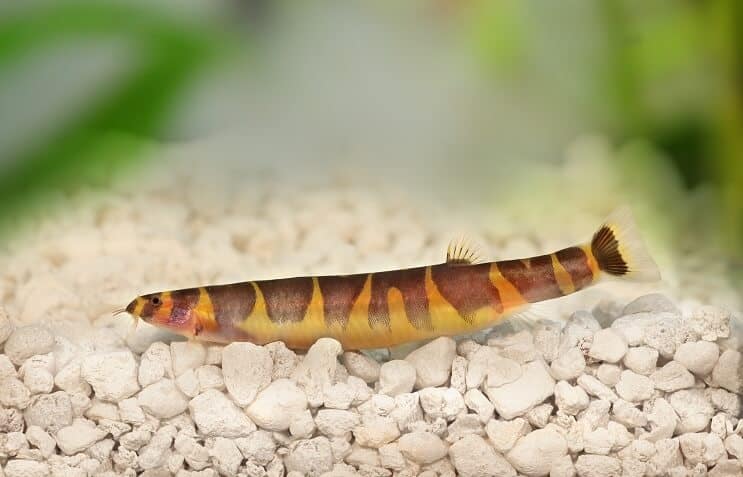
Breeding kuhli loaches is difficult and is only recommended for expert fishkeepers because of the exact tank conditions required.
To breed kuhli loaches, follow these steps:
- Set up a separate breeding tank with dense vegetation, and raise the water temperature to 82–86°F to encourage breeding. Change 5% of the water every day and keep the water level low.
- Select at least nine kuhli loaches with a male to female ratio of 2:1 (for nine fish, this is six males and three females). Feed the fish a highly nutritious diet of live foods.
- Three or four times per day, sprinkle water into the tank to mimic rainfall in the wild, which encourages breeding. If a female signals to a male that she is ready to spawn, the pair will swim around the tank together and stay near the surface of the water to spawn.
- If breeding is successful, a clutch of up to 400 bright green eggs will sink to the bottom of the tank.
- Kuhli loaches don’t have parental instincts and may eat their babies, so you should remove the parents and any other adult fish from the breeding tank and return them to their home tank.
- Within two days the eggs will hatch, and the fry will swim freely by the third day.
- Feed the fry liquid fry food for the first week, then feed them baby brine shrimp for the following six weeks. After their first seven weeks, feed the fry the same food that you feed adult kuhli loaches. At this point, the fry are ready to join the home tank with adult fish.
Should You Get a Kuhli Loach for Your Aquarium?
You should get a kuhli loach for your aquarium if you have a peaceful community tank and you can provide frequent water changes and good oxygenation.
If you’re a beginner aquarist looking for a hardy, low-maintenance fish, or you’re looking for a fish to house with aggressive fish, kuhli loaches aren’t the best choice for you.
Despite requiring more care than other freshwater fish, kuhli loaches are a unique, friendly addition to a home aquarium.
Kuhli Loach FAQs
- Do kuhli loaches need a heater?
- What should I feed my kuhli loach?
- Can kuhli loaches live with neon tetras?
- Can kuhli loaches eat algae wafers?
- Can kuhli loaches live with angelfish?
- Will kuhli loaches eat shrimp?
- Why do my kuhli loaches keep dying?
- Can kuhli loaches be kept in a 5-gallon tank?
- Can bettas live with kuhli loaches?
- Will a kuhli loach eat snails?
- What is the lifespan of a kuhli loach?
- Can I put a kuhli loach in a 10-gallon tank?
- Can I keep just one kuhli loach?
- Do kuhli loaches need to be in groups?
- How many kuhli loaches can be kept in a 5-gallon tank?
- How big of a tank does a kuhli loach need?
- How many kuhli loaches should I get?

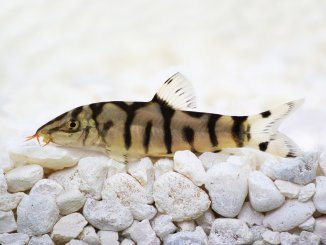
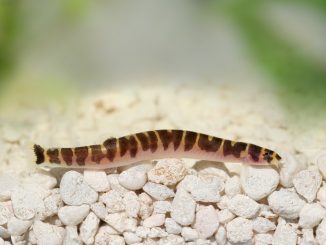
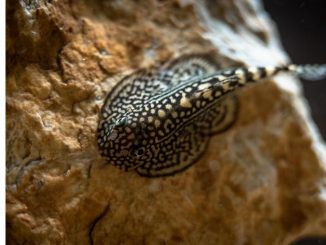
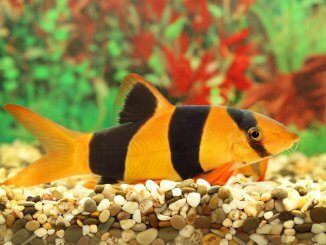
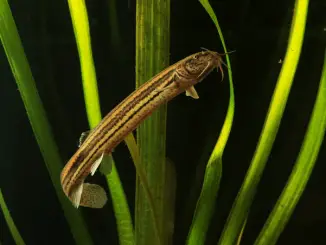
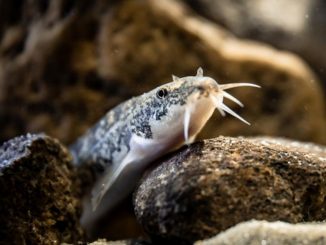
Have tried keeping these fish a few times. They do not do well without many friends in the tank.
How often do Kuhlis get eggs?
I just bought seven and two of those are carrying eggs. They don’t seem like they’re adults. One of them is probably about 6cm
I loved reading this article, very informative… I can only hope our kuhli loaches live to be 10! We have 3 in our 55 Gallon (though after reading this article I’m going to add 3 more) ours are so fun. They definitely aren’t just night scavengers. Ours all three come out when I get ready to feed them and are active in our tank all the time. We have an eclectic mix and they get along with everyone. We recently added the khuli loaches (6mth ago) and I am so glad we did
I had 3 of these in a community tank years ago. One of them dissappeared for A YEAR. I never saw it through numerous substrate vacuuming and water changes. Then one day, there were once again 3 of them foraging around the bottom eating food flakes.
That is so funny, I have a simular story I had originally gotten 2 from my lfs and they kept going inside of a log I had in there and then they disappeared so took out the log shook it out…could not find them so I sadly assumed they died and had been eaten or got trapped in the log. Few weeks pass I decided to redecorate plants had taken over and to my surprise I had 3 kuhli’s 2 about 3in and another one about 1.5in! 6yrs later still have the 3! I would love if they live 10yrs! Great article, love these fish!
I just got 10 for a 150 gallon tank, sounds about right.
I have 3 Kuhli loaches and 1 is 15yrs old. He’s chocolate colored. We call him prehistoric because he’s been around for so long. One of the others has gotten very rounded and large so she could be pregnant.
I have a disease in my tank which seems to be bothering my khuli’s but not my other fish. This is my Third Khuli to get it and it had displayed the same on all three. It looks like a white pencil eraser size lump in the mid back. I think it looks more bacterial then parasitic. However I know khuli’s are prime to parasites so I don’t want to rule that out. Ich is usually small dots scattered, whereas this is one large sore. I tried to treat with a broad spectrum agent but that made my well khuli’s not look so good, so I stopped, changed and filtered the water. I would like to maybe try a more specific agent to target what is actually bothering them but not sure what it is. Anyone else have a similar issue?
My aquarium is 30 years old. I have successfully had khuli’s before usually 4-5 years.
We put 3 Kuhli loaches in our aquarium about a year ago. Last night while I was feeding them, babies suddenly appeared from under rocks and gravel. I have no idea how many there are, but I saw at least 4 little 3/4” long loaches. It was a big surprise because it’s the first time we’ve had any fry ever.
Could I keep these fish with pictus catfish? Or would it be to stressful on the fish?
I have a large tank (125 g.) and I discovered the most exciting thing last night. I have 3 cinnamon loaches. I generally only see two of them so I was afraid the third had died (my parrot fish will eat a dead fish so I don’t always find a body). Last night I cleaned my aquarium really well and moved things around and I found a small fourth cinnamon loach which means one of them laid eggs and one survived! It was a very exciting discovery.
We have two kuhli loaches in a 77 gallon aquarium that are over 25 years old. They have been in a tank with angelfish and African cichlids and we have never had any problems with keeping them together. We see them a lot when the tank is cleaned and
rearranged; they are so curious .
I am a beginner and I got I think a kuhli loach. well at least that’s what I ask for at the pet store. I just recently added more plants and I got it log for it to hide in. I’ve had it for like 2 days and it was hurting but today for a while now it’s been swimming frantically up and down the glass is that normal it only have one cuz I have a 10 gallon tank should I have more than that. I’m hoping to soon get a hundred gallon tank from a friend but all I could afford was a 10. so far I have a female glow betta 5 neon tetras, an algae cleaning fish I can’t remember what kind I have to snails and then I ended up somehow I’m getting a different brand of snail in the water. I figured that’s funny for the tank my betta is not aggressive. matter fact she loves playing with the neon tetras and I’m suing getting at 5 ghost shrimp is it just my lotus happy or is there something that I’m doing wrong and that is stressed about?
Such an awesome fish … once my molly thought it was a worm and tried too eat it!
Great article. I got my 3 today – think I’ll get a few more. Interesting that you said they can live with cherry shrimp… Won’t they eat the shrimp?
Very good information! I Think one of my loaches might be “pregnant” but they are so fast im not sure. They have all the things mentioned above exept floating plants, so im going to the lfs When i Can. I really hope she is “pregnant” and i Will Get kuhli babies <3
I am looking to add some to my tetra tank. I have the stratum planting substrate. I know it will not harm them, but can the loaches still dig?
I am looking to add some to my tetra tank. I have the stratum planting substrate. I know it will not harm them, but can the loaches still dig??